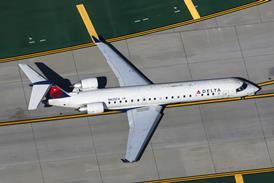For the US majors the third quarter figures have provided little relief, but efforts to rein in costs are working, reports David Field.
The third quarter loss from the US majors was "grim but largely in line" with expectations, in the words of JP Morgan analyst Jamie Baker. The quarter, which a year ago had included the terrorist attacks, came in at just under $1.5 billion before special items.
Few now see any chance of a recovery even into 2004. Gary Chase of Lehman Brothers thinks 2004 is the first opportunity for any improvement in domestic pricing. Revenue is still weak, dipping 4% in the third quarter, and Warburg's Sam Buttrick warns that the weakness will remain until corporate profits recover and companies get "sloppy again" with travel costs.
Air Transport Association senior vice-president of industry policy John Meenan projects that collective losses for its members will hit $9-10 billion for the full year, up from an earlier estimate of more than $7 billion.
Positive signs include operating profits at four groups, as well as the fact that seat costs fell faster than yields, America West and US Airways each managing a cut in unit costs of better than 10%.
Lehman's Chase picks out Northwest Airlines, which is outperforming domestically, with Delta Air Lines also doing well.
However, there is consensus that American Airlines is attacking cost on the widest basis. It has already agreed the sale of Executive Airlines and has said that pretty much everything else but the airline is available for a price. The group is rescheduling major hubs and has begun to engage labour on ways to save money without concessions. CSFB analyst Jim Higgins says that American more than anyone is "focused on thoughtfully adjusting its business model" to adapt to weaker revenue. But that may be a necessity given a cash burn of about $5 million a day.
Its latest round of cost cuts includes a 16% cut in domestic capacity and a corresponding increase in international flying, including Latin leisure routes. It hopes to save about $550 million from consolidating headquarters buildings from 11 to two in the Dallas/Fort Worth area and readjusting employee benefits. Its much publicised hub depeaking should save another $100 million a year.
Those cutbacks are part of a second round of cuts since the summer, and Delta and Northwest have joined in with their own reductions. Delta's move toward another $2.5 billion in cuts over the next three years will trim 1,200 management positions and 800 mechanic jobs, while closing maintenance facilities in St Louis and Anchorage, Alaska.
Northwest, which has cut $1.1 billion in fixed costs since the 2001 attacks, has pledged to look to all of its suppliers, including airports, to cut costs. The airline plans to keep capacity flat in 2003, down from a 3% increase that it had forecast as recently as September.
Buttrick sees a fundamental change in the degree to which the carriers have shrunk their share of the US economy: falling from a traditional 1% to around 0.75%. "This is more than a cycle and more than a cyclical downturn," he concludes.
Buttrick argues that if carriers are to survive by increasing revenues as well as by cutting costs, they will have to look at the leisure sector. Business travellers, he believes, have largely accepted that their fares are too high and have shifted away permanently, which could expose leisure fares as being too low.
That makes all the more interesting Delta's experiment in setting up a new low-cost unit using Boeing 757s in a single-class charter configuration.
Delta is also making $500 million savings by transforming its retirement plan for all workers and putting pilots into a "cash balance" plan under which it makes annual rather than monthly payments. This is part of what Delta chief financial officer Michelle Burns calls "a marathon" among the majors to see which can cut cost the most without driving away business.
Source: Airline Business























